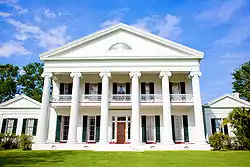Henry Howard (architect)
Henry Howard (1818–1884) was an Irish-born American architect. Over the course of four decades, he designed over 280 buildings in Louisiana, including several plantation houses during the antebellum era. After the Civil War, he designed many town houses in New Orleans.
Henry Howard | |
|---|---|
| Born | February 8, 1818 Cork, Ireland |
| Died | November 25, 1884 (aged 66) New Orleans, Louisiana, U.S. |
| Cause of death | paralysis |
| Occupation | Architect |
| Spouse(s) | Miss Richards |
| Children | 11 |
| Military career | |
| Allegiance | |
| Service/ | |
| Years of service | 1861–1865 |
Early life
Henry Howard was born on February 8, 1818 in Cork, Ireland.[1][2] He emigrated to the United States in 1836, first living in New York City.[2] Within a year, he joined his brother in New Orleans, Louisiana.[2][3]
Career
Howard first worked as a builder/carpenter in New Orleans, where he built residential stairs.[2] He was employed by architects James H. Dakin and Henry Molhausen.[1][2][4] A few years later, he completed the Pontalba Buildings, started by James Gallier.[3]


By 1848, he designed the Madewood Plantation House near Napoleonville.[2] He went on to design several other plantation mansions, such as Nottoway (1859, the largest surviving plantation house in the South), Belle Alliance, Indian Camp Plantation (1859), Belmont Plantation in St. James Parish, and Edgewood (1859) in Natchez, Mississippi .[5]
Howard also designed town houses like the Samuel W. Logan House, the Robert H. Short House[5] and the Goldsmith-Godchaux House (1859). The Goldsmith-Godchaux House is "significant for its painted interiors. Has more fresco wall decoration and stenciling than probably any other mid-nineteenth century residence in the South."[6]

In at least a few of these projects, Howard worked with a partner, Albert Diettel, including Edgewood and possibly Indian Camp Plantation.
During the American Civil War of 1861-1865, Howard joined the Confederate States Navy and worked at the Confederate Naval Iron Works in Columbus, Georgia.[2]
After the war, Howard resumed designing houses.[3] Over the course of his career, he designed over 280 buildings,[3] some of which were wrongly attributed to James Gallier.[2]
Other works
- Belle Grove Plantation, Iberville Parish, Louisiana
- Carrollton Courthouse, New Orleans
- White Hall Plantation House, Pointe Coupee Parish
Personal life and death
Howard married Miss Richards of New York; they had 11 children.[2] He died of paralysis on November 25, 1884, in New Orleans.[7]
Further reading
- Brantley, Robert S.; McGee, Victor (2015). Henry Howard : Louisiana's Architect. New Orleans: Historic New Orleans Collection. ISBN 9781616892784. OCLC 915362089.
References
- Matrana, Marc R. (2009). Lost Plantations of the South. Oxford, Mississippi: University Press of Mississippi. p. 188. ISBN 9781578069422. OCLC 837080857.
- Dufour, Charles L. (December 1952). "Henry Howard: Forgotten Architect". Journal of the Society of Architectural Historians. 11 (4): 21–24. doi:10.2307/987585. JSTOR 987585.
- Marshall, Keith (June 1, 2015). "The legacy of Henry Howard, one of New Orleans' most influential architects". The Times-Picayune. Retrieved March 28, 2017.
- Merrill, Ellen C. (2005). Germans of Louisiana. Gretna, Louisiana: Pelican Books. p. 120. ISBN 9781589802445. OCLC 55600579.
- "Henry Howard's Louisiana". Architectural Digest. June 30, 2015. Retrieved March 28, 2017.
- Goldsmith-Godchaux House at Historical Marker Database, retrieved 4 Nov. 2017.
- "Henry Howard Dead". The Montgomery Advertiser. November 26, 1884. p. 1. Retrieved April 15, 2017 – via Newspapers.com.
External links
- Henry Howard in Louisiana Historical Association's Dictionary of Louisiana Biography
- Henry Howard at Find a Grave
